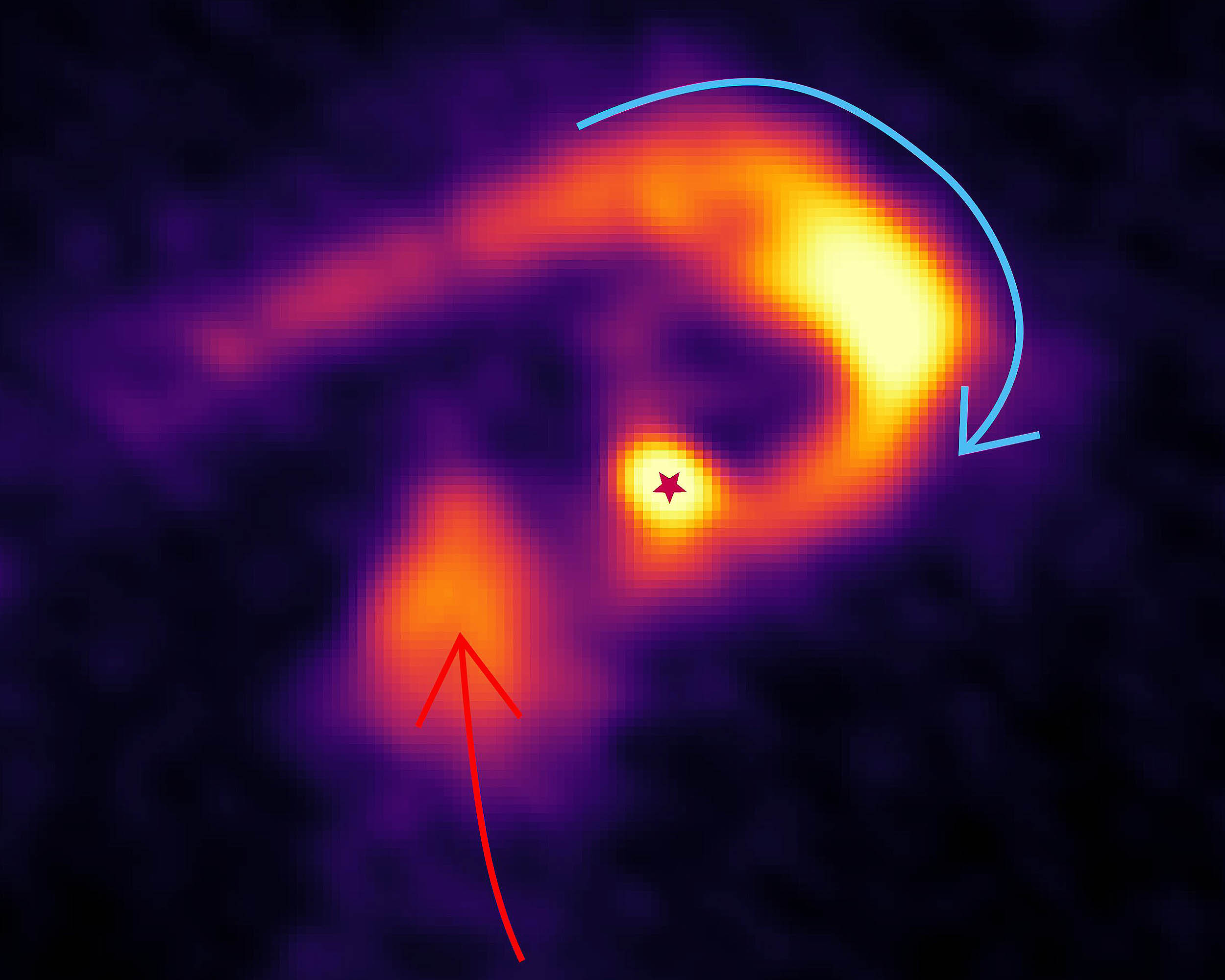High-mass stars form quickly and push back hard on their surroundings. Radiation and winds should strip away the very fuel they need to grow, yet these stars still bulk up fast.
A new study points to a simple answer: long, dense streams of gas that deliver material straight to the center of action, even where a classic disk is hard to find or very small.
ALMA finds streams
The study was led by Fernando A. Olguin of Kyoto University with collaborators in Japan, Taiwan, China, and the United States.
Using the Atacama Large Millimeter/submillimeter Array in Chile (ALMA), the team examined a young, massive source called G336.018-00.827 ALMA1.
They found two gas streams converging toward the protostar, one of which connects directly to the central region, with a clear change in velocity that signals rotation and infall.
The researchers expected a prominent accretion disk a few hundred astronomical units across.
Instead, they saw spiral arms reaching inward and either no large disk or an extremely compact one, likely smaller than 60 astronomical units, or about 5.6 billion miles.
“Our work seems to show that these structures are being fed by streamers, which are flows of gas that bring matter from scales larger than a thousand astronomical units, essentially acting as massive gas highways,” said Olguin.
Gas streamers help stars grow
Astronomers classify high-mass stars as those above roughly eight times the Sun’s mass. According to a 2002 study, that threshold marks a regime where radiation pressure and ionized winds become strong and can choke off simple spherical collapse.
In massive protostars, theory and observations indicate that non-spherical accretion is needed, helping radiation escape through polar regions while matter continues to arrive through denser paths near the midplane.
A recent preprint explains that streamers fit this bill because they channel gas along narrow tracks with high momentum.
The ALMA1 data show that the western, blueshifted streamer carries enough material inward to overwhelm local feedback near about 61 astronomical units, which is approximately 5.7 billion miles.
That supply helps maintain a dense inner region where growth can continue despite radiation pressure from the young star.
These flows do not need to end at the disk edge. In ALMA1, the observed streamers penetrate well inside the expected disk radius, potentially feeding a very small unresolved disk or even the protostar itself, which changes how we picture the last link in the inflow chain.
ALMA shows spiral gas
ALMA’s long-baseline setup delivered a sharp view, resolving features on scales of about 86 astronomical units, or roughly 8 billion miles.
The team mapped both dust emission and several molecular lines, including methanol and sulfur monoxide, to trace motion and temperature structure around the central source.
Those tracers reveal a velocity gradient along one streamer that bends at a characteristic radius near 500 astronomical units, or about 46.5 billion miles.
The change implies a shift from infall-dominated flow to rotation-dominated motion as the gas nears the center.
Gas streamers beat radiation
Kinematic modeling indicates that the outer segment of the blueshifted streamer behaves like a rotating, infalling envelope.
Inside roughly 500 astronomical units, the speeds line up best with near-Keplerian rotation, as expected when gas settles into a compact structure before reaching the protostar.
At the point where the flow turns, the team sees signs of shocks that heat and concentrate material.
Vibrationally excited sulfur monoxide is compact and peaks near that location, consistent with gas slamming into denser regions as it changes course toward the inner system.
Mass estimates for the inner streamers fall in the range of a few tenths of a solar mass, with inferred infall rates high enough to replenish the center on useful timescales.
The modeled momentum of the inflow exceeds the local radiation force by about two orders of magnitude near the inner radius, which explains how accretion continues.
Taken together, the picture is simple. A large-scale reservoir funnels material into extended spiral arms, the arms feed narrow streamers, and those streamers push gas right into the inner tens of astronomical units where star growth is decided.
Gas streamers replace big disks
Large, rotating disks around young massive stars do exist. ALMA has imaged a roughly 1,000 astronomical unit disk with a prominent spiral arm around the forming O-type star AFGL 4176 mm1, a clear case where a massive disk structures the flow.
Streamers have also been spotted feeding lower-mass protostars, where arc-like flows guide gas from envelopes into compact inner regions.
That broader record suggests that filamentary feeding is a common tool nature uses across stellar masses, not just an outlier in one cloud.
ALMA1 shows that a large, obvious disk is not required for a high-mass protostar to keep growing.
A very small disk can still be present, but the heavy lifting can be done by the streamers themselves if the reservoir and geometry cooperate.
That flexibility helps resolve a long-standing tension in massive star formation.
If radiation pressure gets strong early, steady supply lines must find a way to keep delivering mass to the center without being blown away, and focused streams are well suited for that job.
What comes next
“We found streamers feeding what at that time was thought to be a disk, but to our surprise, there is either no disk or it is extremely small,” said Olguin.
The team plans to apply the same methods to other regions to test how often streamers dominate the final stages of accretion.
They will also probe even closer to the center to confirm or rule out tiny disks that current data cannot fully resolve.
The study is published in Science Advances.
—–
Like what you read? Subscribe to our newsletter for engaging articles, exclusive content, and the latest updates.
Check us out on EarthSnap, a free app brought to you by Eric Ralls and Earth.com.
—–
